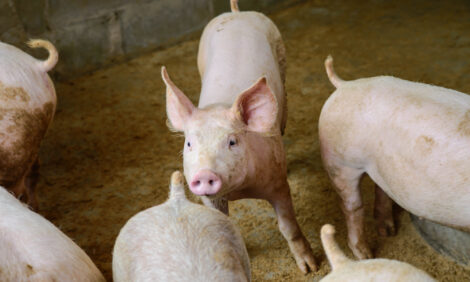



Improvements Made to Food Chain Information in Pig Sector
UK - Improvements are being made in the British pig sector to the way information on meat inspection is collected and communicated along the food chain and back to the producer.At present, information about pig health is collected through two schemes at the slaughterhouse – the British Pig Health Scheme and the statutory collection and communication of inspection results operated by the Food Standards Agency
The BPEX Pig Health Scheme (BPHS) is an industry-sponsored health monitoring scheme established in 2008.
It monitors English pigs at slaughter for incidence and severity of animal disease on member farms, to help pig producers reduce the level of sub-clinical disease within their herds.
Individual data can then be benchmarked against the disease average of others within the scheme.
Assessments are carried out at designated abattoirs by specialist veterinarians.

“Following the assessment, the report is sent to the farmer and to his vet and this allows them to discuss their health plan,” Ouafa Doxon, the health information and food safety co-ordinator at AHDB BPEX told a seminar on information flow in the meat chain.
She added that the producer and vet can also compare the reports with historical data stretching back two years.
However, together with the FSA collection of information from the post mortem examination s at the slaughterhouse, the current system where the BPHS is also being used means that there are two post mortem data collection systems.
Now BPEX is moving to a single system and will be decommissioning the British Pig Health Scheme and adopting the CCIR – collection and communication of inspection results – scheme by 2016.
Ms Doxon said that in moving to a single scheme, some of the good points from the BPHS will be taken up into the FSA scheme.
“We have to improve the quality of the data collected and then improve the communication to the producer and finally the monitoring of the improved system,” she said.
She said that BPEX has been working on the first phase in improving the quality of the data collected, improving the consistency of the data and the practices in meat inspection.
She said that the emphasis had to be on animal and public health in the inspection and not on meat quality.
Part of the improvements in the inspection has to be to simplify and reduce the number of conditions that need to be reported. This is being cut from 30 to just 12.
Other improvements are to ensure that reports are fed back to the producer in a timely manner.
.jpg)
Some of the improvements that are being carried out to the inspection and reporting system are improvements to the systems and technology that is being used on the processing lines and the abattoir floor.
These include improving the software and the touch screens used by the inspectors to record the data as well as improving the training of the inspectors to increase consistency of results.
According to Jose Ruiz, the field veterinary leader at the Food Standards Agency, changes to the programmes are expected to be completed by the end of the year.
Pilot schemes for the collection and communication of inspection results have already been taking place at Tulip processing plants across the UK as well as at processor Cranswick.
The inspection of the carcase and offal on the line look for problems such as abscesses, arthritis, bruising, tail biting, pneumonia and pleurisy and account for any parts that have to be removed to go against the payments to the producer.
Other flaws such as contamination from bile, gut content, hair machine damage, over-scalding that impact on efficiency and yield are recorded as problems within the plant.
With the information now recorded electronically, where as in the past paper records were kept, efficiency has improved and now Tulip is looking to include RFID information on the gambrels so that individual data can be held with each individual carcase.
.jpg)
Inspection on line has been improved with the help of condition cards issued by the Food Standards Agency to help inspectors identify diseases and problems.
Mark Haighton, supply chain manager at Tulip, told the seminar: “Collection and Communication of Inspection Results is very, very important.
“We don’t want to be supplying product to customers that are not safe and we want to provide information back to our producers.”








